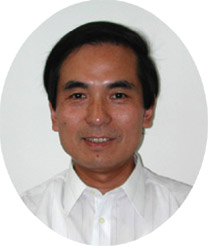| Semiconductor particles with sizes of an order of a few nanometers are called semiconductor quantum dots (QDs). The sizes are larger than the lattice constants but comparable to the spatial extension of the wavefunctions of excitons, electrons, or holes on the corresponding bulk materials. Consequently, the quantum confinement effect occurs and they have new interesting physical and chemical properties completely different from those of bulk materials. Hence, research on semiconductor QDs is developing into a large interdisciplinary field. Owing to the quantum confinement effect, they show the size-dependent optical properties in particular, such as optical absorption, photoluminescence (PL), and large optical nonlinear properties. Thus, they have potentials and promises both for the basic study of the three-dimensional confinement in semiconductors and for the applications in the field of optoelectronic devices. We are investigating the optimal synthesis conditions for their applications to optical energy conversion devices and characterizing the relation between relaxation processes (radiative and nonradiative) and optical energy conversion in semiconductor QDs together with the steady state characterization for the following topics: |
(1) Nanostructured oxide semiconductors such as TiO2 and composite of ZnO and SnO2 which are promising candidates for photoanode materials applied to solar cell fabrications. Optical absorption prospects are increasing with depositing oxide semiconductors in a nanometer-sized structure that offers a large surface area.
(2) Oxide semiconductors have low solar energy conversion efficiency because of their wide band gaps. For solar cell application, organic dye sensitization is one of the methods used to extend the photoresponse of the electrodes to the visible region. In addition to organic dyes, narrow band gap semidonductor QDs, such as CdS, CdSe, and PbS, have attracted significant interest as light harvesters in solar cells. We are investigating the effects of nanostructure of the electrodes sensitized with semiconductor QDs on optical absorption, photocurrent properties, optical energy conversion, and relaxation processes in order to get the optimal conditions for solar cell fabrications.
(3) ZnS QDs doped with transition metal ions, such as Mn2+, have attracted much attention in the past few years due to the change in their optical properties in accordance with the quantum confinement effect. They form a new class of luminescent materials because of the high fluorescence quantum efficiency (~18%) compared with bulk materials. We are investigating the effects of surface passivators and ultraviolet irradiation in order to achieve the increase of fluorescence quantum efficiencies together with radiative and nonradiative relaxation processes. |
